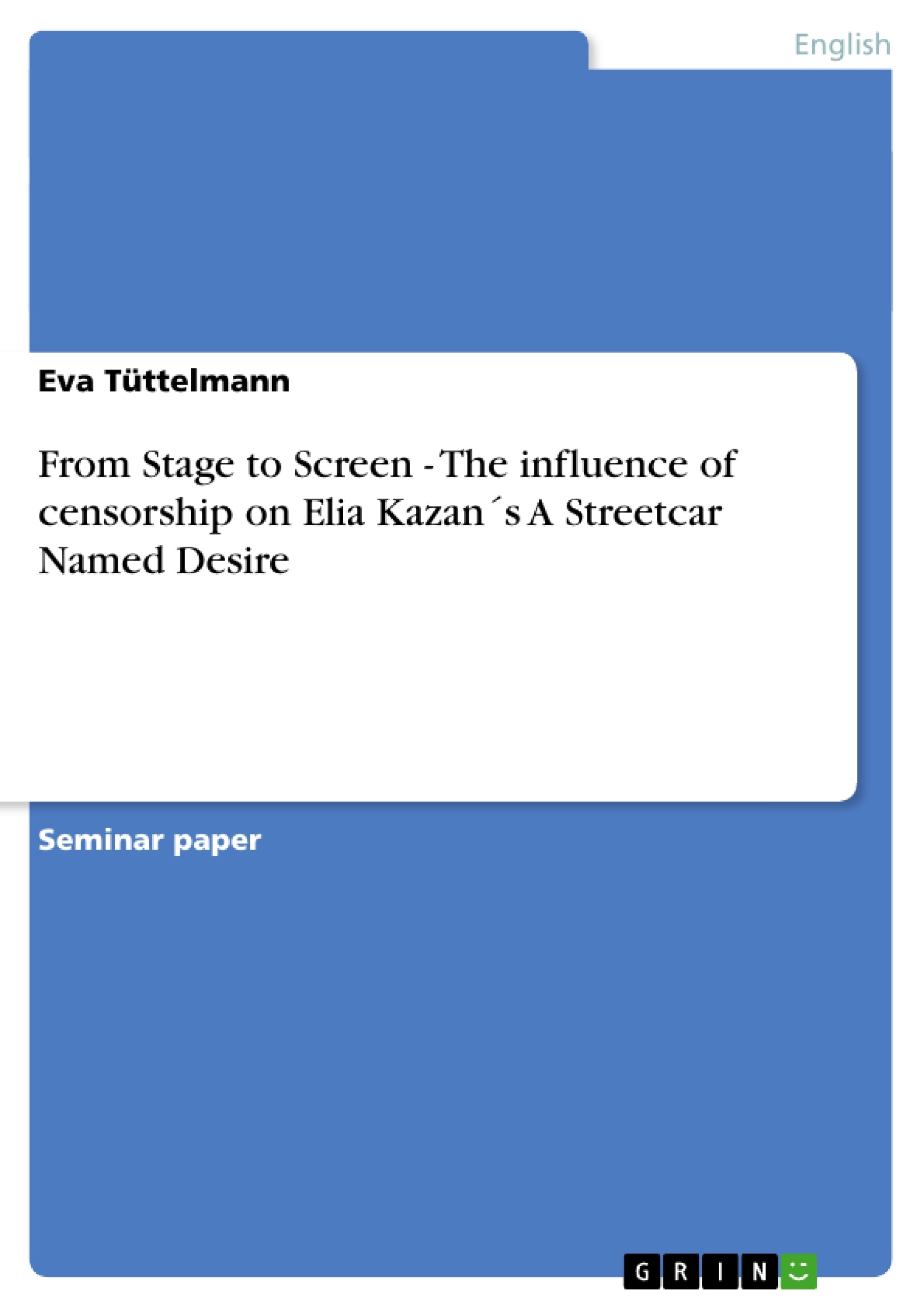Tennesse Williams' play A Streetcar Named Desire is one of the most successful plays in the history of American drama. It was written in 1947 and first staged on December 3, 1947 at the Barrymore Theatre in New York. Blanche DuBois was played by Jessica Tandy, who had worked with Tennessee Williams before. Marlon Brando played Stanley Kowalski and Kim Hunter played Stella, his wife. The Broadway stage production was directed by Elia Kazan.
As the play had been such a great success one quickly began to discuss the production of a film version. Nearly the entire Broadway cast was kept for the film, apart from Jessica Tandy, who was replaced by Vivien Leigh. Leigh seemed to promise a larger success due to her award-winning performance in Gone with the Wind about ten years earlier. She had played Blanche in Laurence Olivier's production of A Streetcar Named Desire in London. Similar to the play, the film was directed by Elia Kazan.
Kazan's attempt was to stick to the play as much as possible. He and Tennessee Williams were working together closely on the development of the script. The screenplay itself was written by Oliver Saul who had to rewrite a few passages but mostly followed the dramatist's version.
The plot of A Streetcar Named Desire raised the interest of industry censor Joseph Breen, who was "the official administrator of the Code of the Motion Picture Association of America" (Phillips 1980: 81). Breen doubted the subjects discussed in A Streetcar Named Desire to be acceptable in case that they were presented in a motion picture. Although both Williams and Kazan were in opposition to the censor's demands, they were forced to find compromises as the association's influence on the audience was remarkably strong.
This paper discusses the scenes that had to undergo a change as a consequence of censorship. I will compare the dramatic text and action with the film plot and try to depict the problems concerning the story, which do appear, even if Kazan and Williams did their very best to avoid this. I will illustrate how Kazan used subtle images and hints in attempt to transport the message he had been forbidden to transport. The ending of the film is of special interest and will be dealt with more explicitly as it changes not only the plot but also special features of the characters.
Small modifications through which only little is lost in translation will not be discussed.
Inhaltsverzeichnis (Table of Contents)
- Introduction
- "No appropriate film project": Joseph Breen and his demands on A Streetcar Named Desire
- The compromise with the MPAA
- Censored scenes
- Raw meat
- Allan Grey
- The rape
- Symbolic cutting
- The ending: Punishing the brute
- Revision
- Stella
- Stanley
- Blanche
- Conclusion
Zielsetzung und Themenschwerpunkte (Objectives and Key Themes)
This paper focuses on the censorship applied to Elia Kazan's film adaptation of Tennessee Williams' play "A Streetcar Named Desire." It analyzes the impact of Joseph Breen, the head of the Motion Picture Association of America (MPAA), on the film's content, specifically regarding scenes involving homosexuality and rape. The paper examines the compromises made by Williams and Kazan to appease the MPAA, and the subtle ways Kazan uses imagery and hints to convey the original message despite censorship.
- Censorship of controversial themes in film
- The impact of the MPAA's Production Code on artistic expression
- Comparison of the play and film versions of "A Streetcar Named Desire"
- The use of symbolism and subtext in film to convey censored content
- The manipulation of the ending of the film to accommodate censorship
Zusammenfassung der Kapitel (Chapter Summaries)
- Introduction: This chapter provides background information on the play "A Streetcar Named Desire," its success on Broadway, and the transition to a film adaptation. It introduces Elia Kazan as the director and highlights the involvement of Tennessee Williams in the script development.
- "No appropriate film project": Joseph Breen and his demands on A Streetcar Named Desire: This chapter introduces Joseph Breen, the head of the MPAA, and his concerns regarding the content of the film. It focuses on Breen's view that the film's themes, particularly homosexuality and rape, were unsuitable for a family audience. The chapter also outlines the strict guidelines of the Motion Picture Production Code.
- The compromise with the MPAA: This chapter discusses the compromises made by Williams and Kazan to comply with Breen's demands. It touches upon the omitted references to homosexuality and the challenges faced in dealing with the controversial rape scene.
- Censored scenes: This chapter delves into specific scenes that were censored, including the reference to Blanche's homosexual husband, Allan Grey, and the rape scene. It analyzes the changes made in the film version and the impact of these alterations on the narrative.
- Symbolic cutting: This chapter explores the ways in which Kazan uses subtle imagery and hints to convey the censored content. It analyzes how the film relies on symbolic representation to maintain the essence of the story.
- The ending: Punishing the brute: This chapter examines the changes made to the ending of the film to appease the MPAA. It explores the modifications made to the characters of Stella, Stanley, and Blanche, and the overall impact on the film's conclusion.
Schlüsselwörter (Keywords)
This preview focuses on censorship, film adaptation, Tennessee Williams, Elia Kazan, A Streetcar Named Desire, MPAA, Motion Picture Production Code, homosexuality, rape, symbolism, subtext, and artistic compromise.
- Arbeit zitieren
- Eva Tüttelmann (Autor:in), 2006, From Stage to Screen - The influence of censorship on Elia Kazan´s A Streetcar Named Desire, München, GRIN Verlag, https://www.grin.com/document/75877



